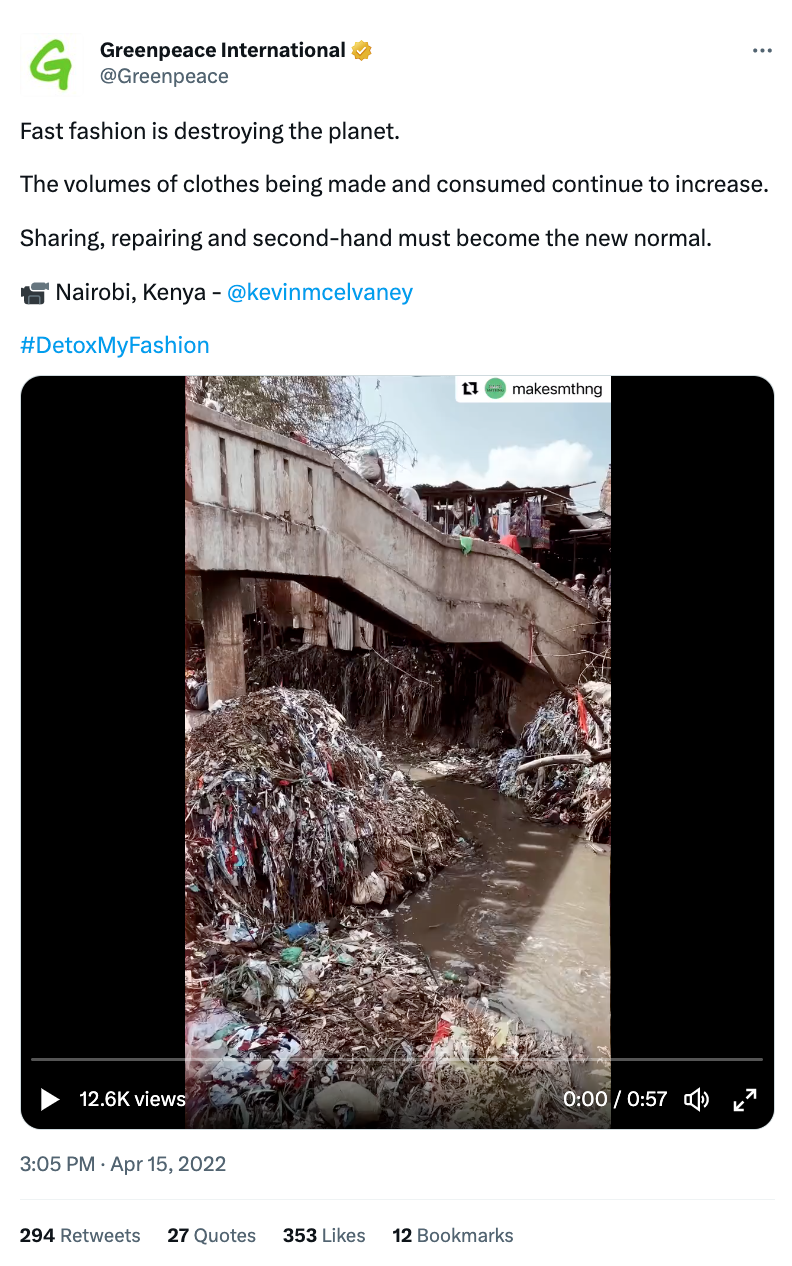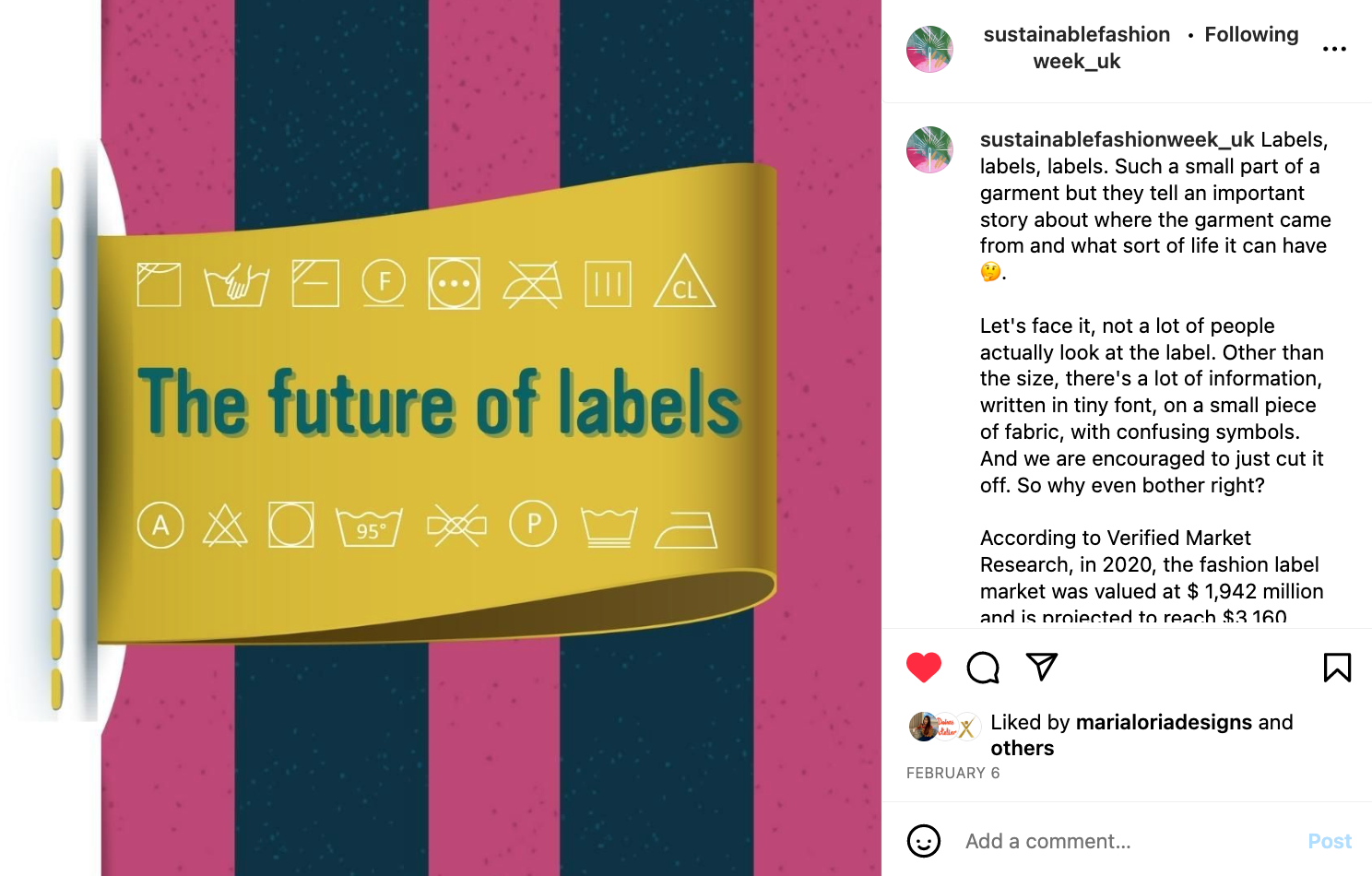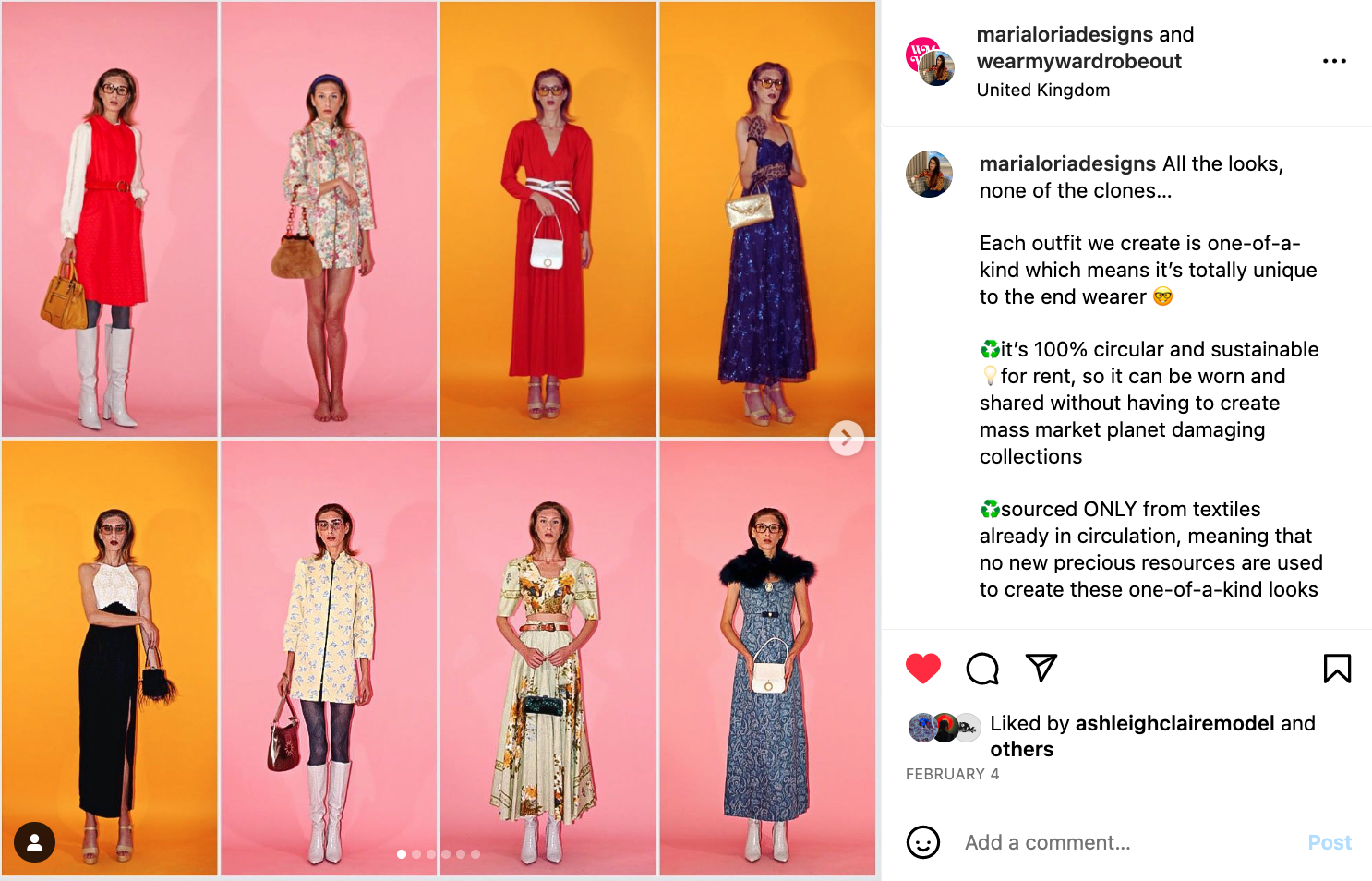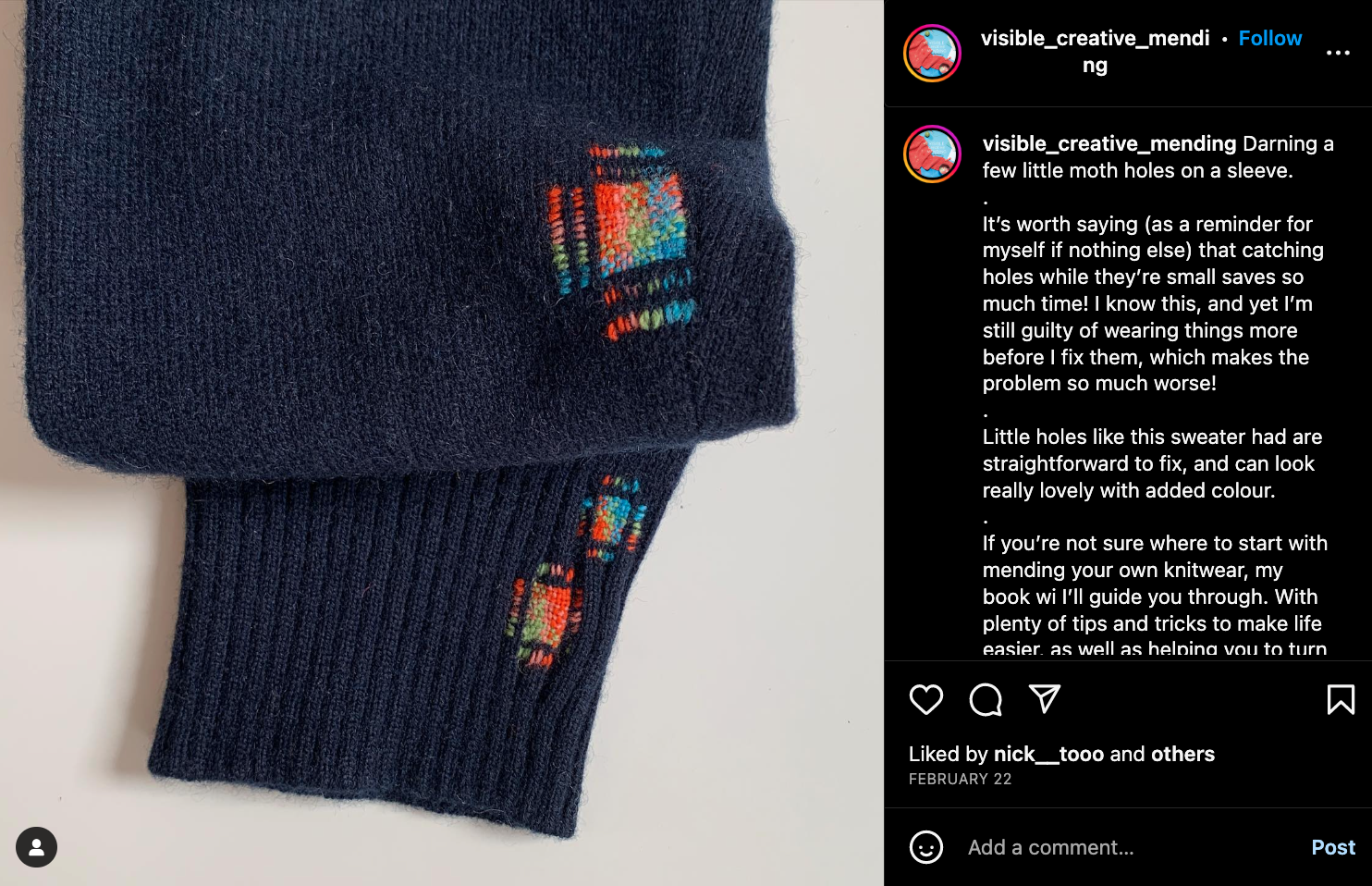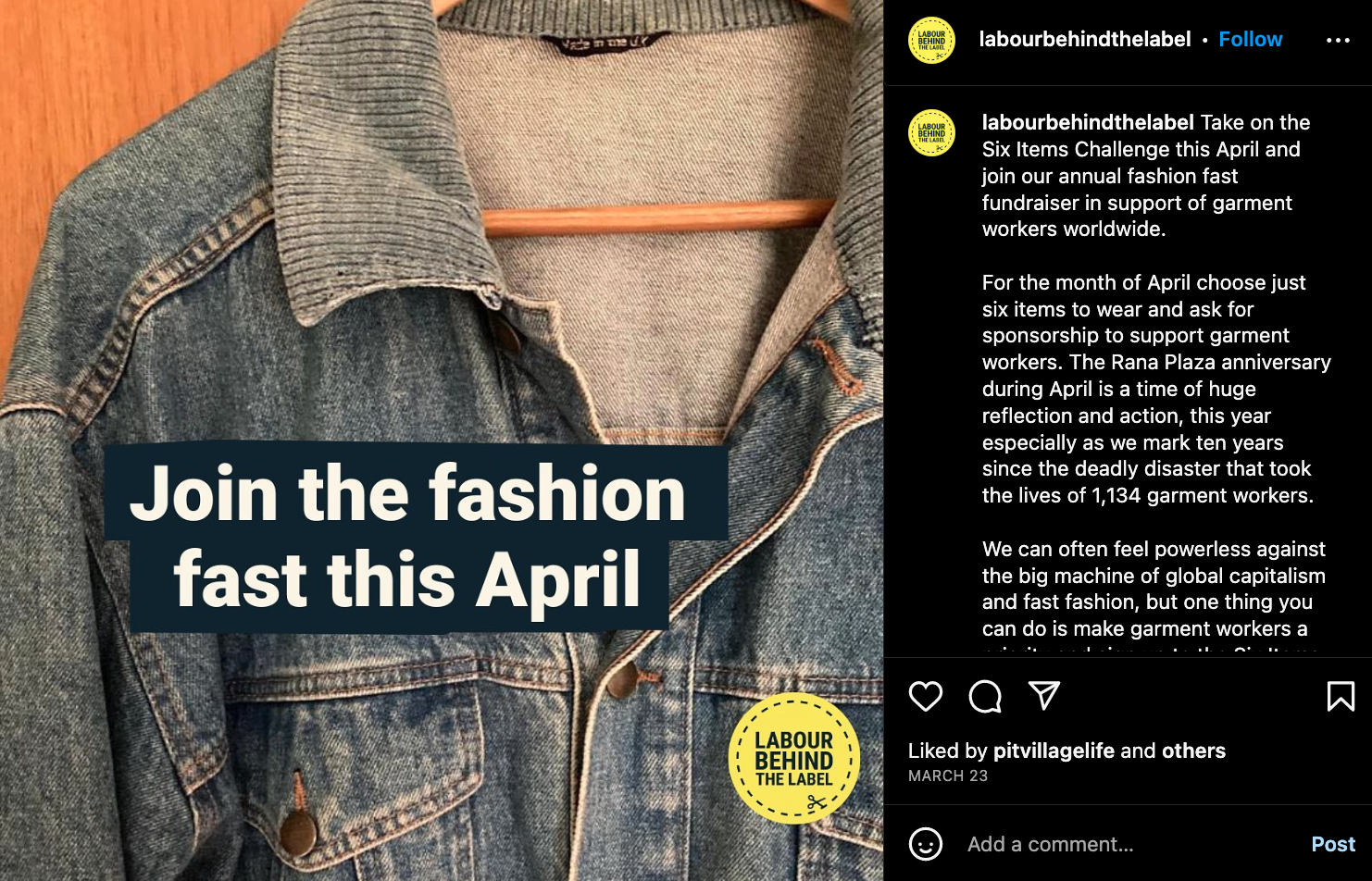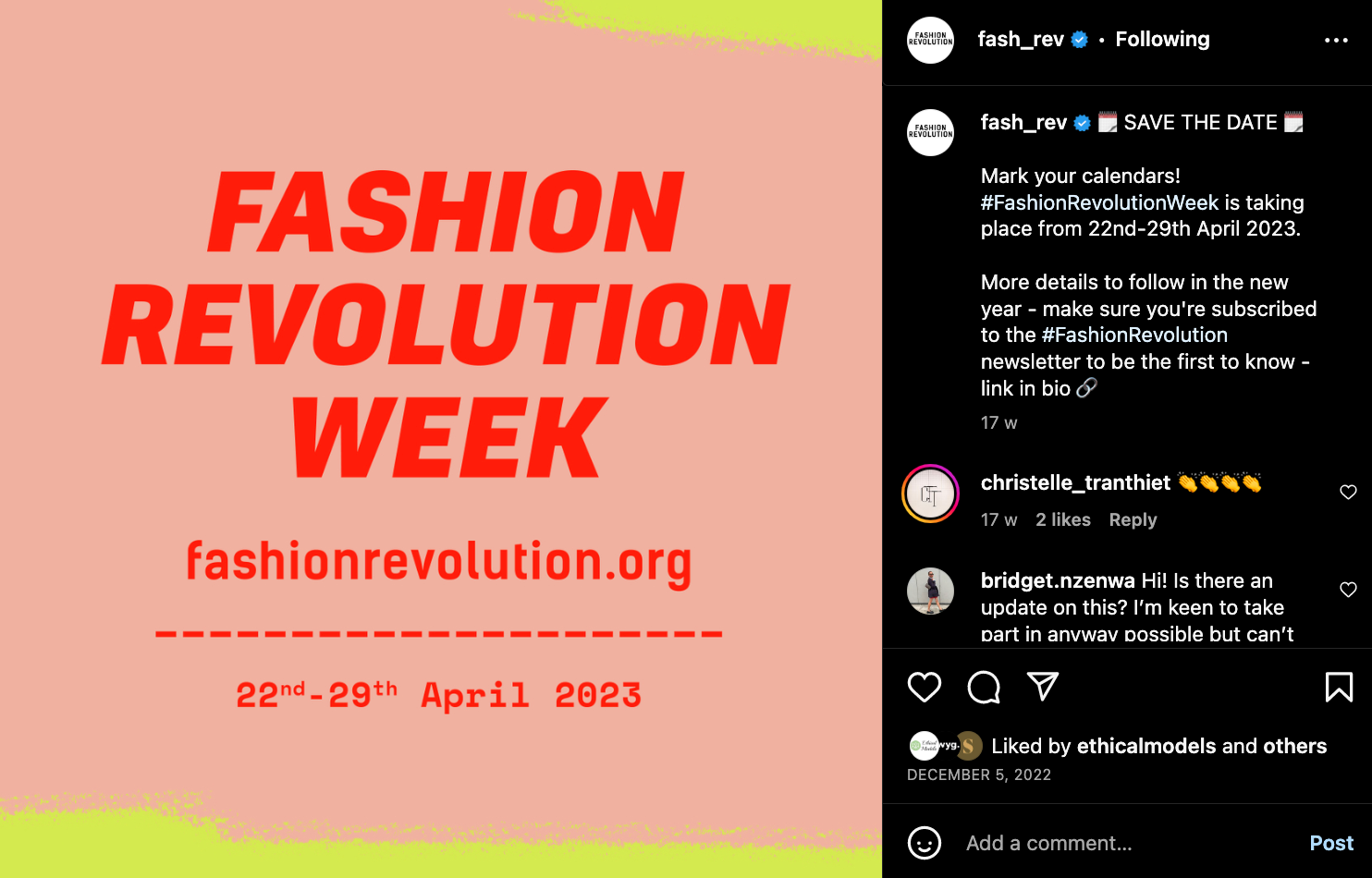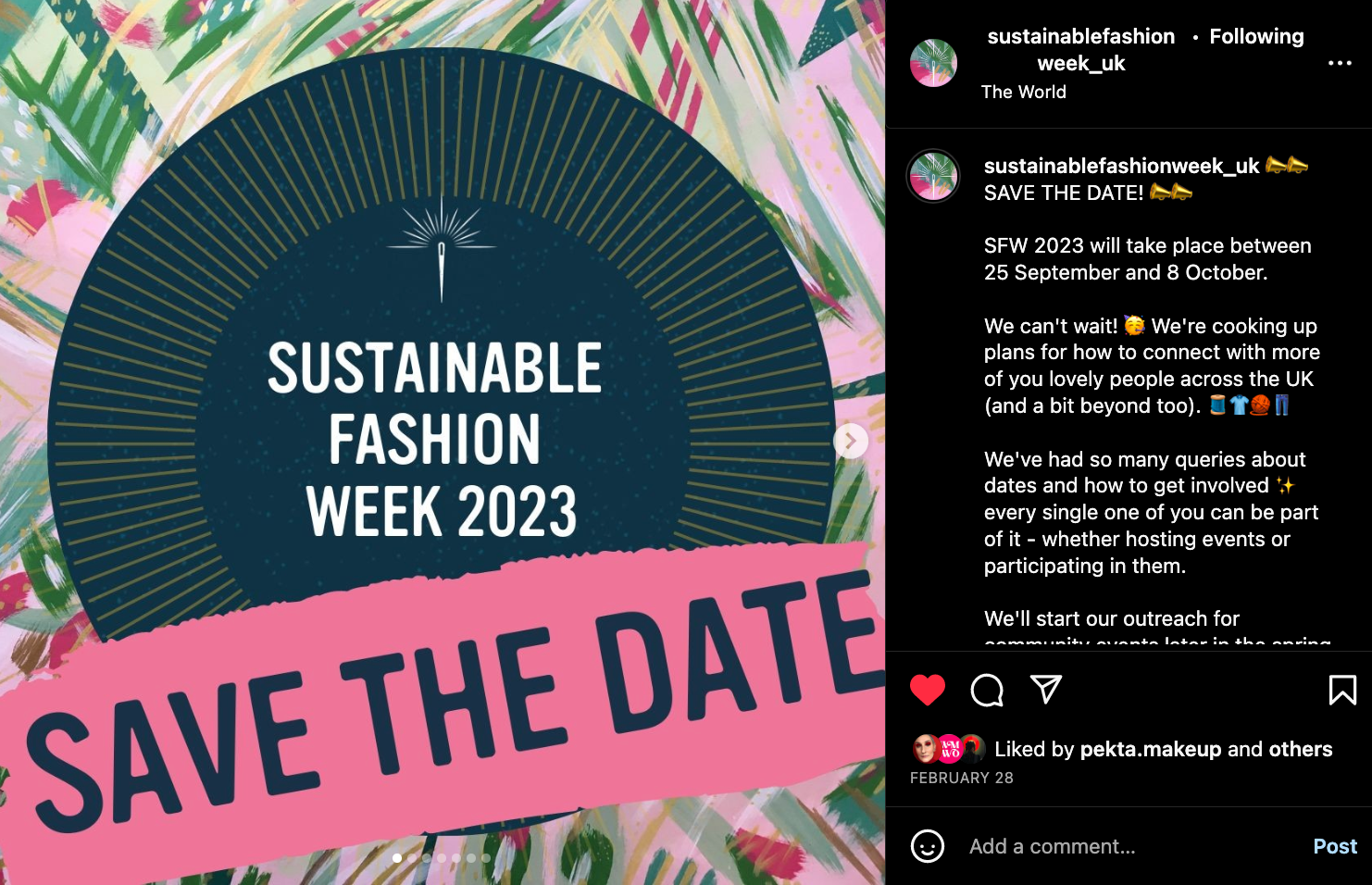How to ditch polluting fast fashion for a more ethical and sustainable wardrobe
Helle is a Director of Sustainable Fashion Week but has written this blog in her role as an environmental fashion and human rights writer for Greenpeace UK.
The global fashion industry is long overdue a detox. Each year, billions of tonnes of practically single-use, oil-based polyester clothing waste is exported, and landfilled or burned in poor countries. Worst of all, this clothing “waste” was made by skilled human beings, working in awful conditions. Read a full breakdown of the waste and misery of fast fashion, and a TLDR on what it means for the planet. All evidence shows that the overproduction and overconsumption of fashion is fuelling the climate crisis. Just like changing what we eat can help, changing how we buy clothes can make a difference. Here’s a practical, how-to guide for tackling the mountain of clothes in your cupboards and getting into sustainable fashion. Get started:
The wardrobe audit
The most sustainable clothing you own is already in your wardrobe
There’s nothing wrong with buying clothes for you and your family. But let’s be honest, we often buy without thinking, because it feels good. Shopping is known to be addictive, after all. So we often have far more clothes than we wear. These are all garments and fabric that can be reworn, repaired, sold on or upcycled. Start by creating three piles:
Keep and use. To paraphrase Marie Kondo – does it spark joy, and do you wear it regularly enough? If it does, and it’s in regular use, onto this pile it goes. (Eventually it won’t be a pile at all, but a beautifully organised wardrobe of your favourite pieces, roll-folded in the KonMari wrinkle-defying way.)
Keep and do something cool with. Randomly storing unworn clothes isn’t the goal here. Keep aside pieces to alter or repair, upcycle or use in a different way.
Clear out. This is for things to donate, swap/gift, or sell. This will likely be more than one pile, but you can sort it once you’ve read the section below.
1. Keep and use
Decide whether to keep something by working out whether you actually wear it, and enjoy wearing it. Simple! Make sure you consider:
Seasons – Those amazing things you love, but only wear in summer, for example. Think back to last summer – did you wear it then? Put it into a summer-only pile for a separate place in your wardrobe or under your bed.
Specialist clothing and their specific use cases – Don’t get rid of these flippantly, even if you’ve not worn them in ages. Their time will come around again.
Personal taste – Colours, styles, fabrics, fits. What do you feel good in? What matches your lifestyle?
Try not to worry too much about what’s “in”. This doesn’t actually mean anything anymore – with fashion companies releasing 26 collections a year (or thousands of new styles a day, in the case of Shein). This is about what you like to wear. And it’s about learning to love what you own all over again.
2. Keeping: rediscovery, reinvention and storage
DIY isn’t just for around the house. Why not graft the front of the merch T-shirt onto a cushion cover, to display on your sofa and bring you good memories every time you’re there?
One of my favourite examples reusing sentimental items was on the TV show Escape to the Chateau. Angel couldn’t bear to throw away her daughter’s old T-shirts, so she turned them into a t-shirt quilt. This preserved their memory and looked extremely cool on the bunk bed. There are even companies that will take on all the hard work – like Too Many T-Shirts:
Keeping only your most precious clothing helps focus your time and space on looking after it, too. Wool is the classic – keep it packed away from moths in the summer and it’ll serve you for years.
3. Getting rid: swapping, selling on, giving away
The fashion industry almost wants us to see clothing as disposable – so we can make room for the next season’s trends.
But this does a huge disservice to the people who handmade those items – most likely in miserable, dangerous and even deadly conditions.
And treating clothing as waste is no good for the environment or the climate either. Clothing waste is exported to countries like Ghana, Kenya and Tanzania:
As we now own these items, we should at least attempt to give them a second life after we’re done with them. Here are the options.
Donating to charity
Only 10% of clothes we donate to charity shops are actually sold by them . But this is still the main way to remove clothes from your wardrobe to (hopefully) benefit someone else.
Donate with caution. Make sure you only send good, clean clothing to charity shops. Anything else needs to go in a textile waste bin.
Check whether local homeless shelters or baby banks are asking for specific donations. There are even specialist bra charities that make sure your donations go to those in need.
Clothes swaps, sharing and giving away
Clothes swaps are a fantastic way to trade items that you don’t wear anymore, but still have lots of life left in them.
With the cost of living crisis really starting to bite, you might want to start looking at what you have to offer to friends and family. (Or what they can offer you!)
Some of my favourite clothes have come from piles friends were about to take to the charity shop. And the clothes my mum has given me over the years have served me better than anything I ever bought at Zara.
Reselling
Reselling your clothes is now so mainstream that online marketplaces have splashy advertising on TV, encouraging you to clear out and sell your old stuff. Apps like Depop, eBay, Vinted and Vestiaire (for luxury fashion) are great for reselling clothes in good condition. And reselling services like Thrift are helpful if you don’t want to deal with the listing admin and you’re happy to split any money you make. Check each platform for exact details of what they accept, how they work and fees they charge. Vestiaire recently banned fast fashion listings after a trip to Ghana where they saw the devastating impact of clothing waste on the country’s capital. Just make sure you don’t use reselling to simply keep shopping at the same rate as before!
Care, rewear, reuse, repair
Loved clothes last
What’s in your clothes?
Different fabrics have different superpowers. When you look at what you have (or are seeking to buy new), it’s worth learning about each type of textile.
This is so you can:
Know whether it’s fit for your use, and enjoyable for you to wear;
Learn how to wash and care for it, or throw it away properly; and
Decide what global industries you fund when buying new
Here’s a very quick guide to what fabrics might be in your wardrobe (and a really thorough one if you want to learn more).
Natural fabrics
These are fabrics that come from plants or animals. In theory, this means they are biodegradable. But they’re often grown with fertilisers and pesticides, and made into fabric using lots of water and other chemicals.
Cotton is great because it’s breathable, can be washed at high temperatures and holds dye well (great for a tie-dye project, colour update or change). Aim for organic, fairtrade and OEKO-TEX cotton to reduce your impact and make sure there aren’t any hidden chemicals in your clothing.
Wool is a wonder material because it’s breathable but still super warm, but much of it still comes with animal welfare issues.
Then there are natural fibres that come from plants or trees but are highly processed from their natural state, often called “semi-synthetic”. These show up on labels as viscose or rayon, and modal. Bamboo also fits this category. As you can imagine, it takes a lot of processing to turn wooden canes into fibres.
Synthetic fibres
Polyester – a plastic fibre made from oil – revolutionised the fashion industry fifty years ago. Originally this was because of its incredible properties, like holding colour well and seemingly never wearing out. But synthetic fabrics are not very breathable, and can respond in weird ways to high-temperature washing and heavy use, like bobbling (semi-synthetics can bobble too). And they can’t be dyed very easily.
Synthetic clothing sheds microfibres through washing it in our machines, releasing polluting microplastics into the air and water. Today, synthetic fibres are used for many different things with extremely useful properties – like fine threads for tights, waterproof jackets, or warm fluffy fleeces.
Most clothing containing synthetics is often made with a mix of fibres. This makes the fabric impossible to recycle – contributing to huge amounts of clothing waste that doesn’t break down quickly. When buying new or even secondhand, make sure its synthetic properties are useful for the garment – and that you know you’ll want to keep it for a long time.
Caring for your clothes
Sustainable fashion designer Stella McCartney recommends not washing unless completely necessary. Orsola de Castro’s book Loved Clothes Last has many amazing tips on spot stain removal – even freezing clothes instead of washing them.
Too often, we wash clothes that can be worn again. Simply airing clothes out for a bit can refresh them to wear them again. My recommended kit for this is a clothes horse – a pretty vintage item!
Once they’ve had some air time, hang clothes or fold them inside out in your wardrobe. This helps to keep track of what can be worn again before a wash, and what’s freshly laundered.
When you do have to wash, spot clean stains first – do this before they are set-in by the warm washing machine cycle. And keep temperatures low – 30C is almost always enough
If you have a lot of synthetic fabrics that you really do have to wash often (sportswear, for example), invest in a laundry bag that catches microfibres. Try to mend or repurpose synthetic clothes. You can catch ladders in tights with clear nail varnish, for example. And wash fleeces extremely sparingly!
Rewear
Shockingly, it’s become a trend to buy something, wear it once – maybe for a single Instagram post – and then discard it or return it (try not to do this, as returns are often burned).
This means that simply rewearing your clothes is now an act of revolution against fashion’s human rights abuses and climate impacts. So easy!
Here are some simple rewear ideas to start shifting your mindset:
Mix and match what you already own. Use an app like Smart Closet, which has an automatic outfit creator that helps you see your clothes with new eyes.
Hide away clothes that don’t work for you right now (or that you wear a little too much these days) and “rediscover” them in a few weeks or months.
Pick a garment and wear it every day for 10 days, creating as many different outfits as possible.
Ask to borrow something from a friend’s wardrobe for something to wear to an event, instead of buying new.
Don’t buy “boyfriend” jeans or shirts – wear your boyfriend’s! (Or someone else’s boyfriend’s…best if you find them in a charity shop though.)
Renting clothes is rewear – and isn’t just for designer items costing hundreds for a weekend. Check out Wear My Wardrobe Out.
Repair
I got into repairing because I couldn’t replace a lot of what I had. I’d either bought it second hand or it was an expensive or meaningful gift that still had loads of life left.
Every repair job is a chance to upskill. Learn to:
sew on buttons
close up holes in seams
felt or darn to repair holes in knitted garments. (I have it on good authority that felting is extremely relaxing!)
patchwork or embroider to cover stubborn stains or mend holes – and give new life to your clothes!
Visible mending has also become quite popular lately. This follows long traditions of reuse and mending – like boro in Japan, bojagi in Korea and kantha in India.
For the more tricky jobs, go to a local dry cleaner or an alterations and repair professional.If we’re going to build a new sustainable fashion industry, these will be the people at the heart of it.
A new platform called SOJO offers door-to-door repair and alterations services from their London-based studio. And rental company Wear My Wardrobe Out can also help with alterations, on a 7-day turnaround.
Upcycling and making
There should be no such thing as fashion waste
Upcycling
While it’s become such a sad fact of the modern day clothing system, no clothing is waste unless we decide it is. There’s always something that we can do to make it into something else.
Upcycling doesn’t have to be scary – you don’t need loads of skills, just a desire to keep clothes working for you. The UK is a nation of DIYers when it comes to the home, so why not clothes?
With a simple sewing kit and some basic skills, you can make an old, unloved garment into something you’ll wear and cherish foreverSearch online for simple upcycling ideas, such as:
Cut legs off jeans to make shorts, or make trousers longer by letting down the hem
Reshape a t-shirt into a sleeveless top
Make tops from scarves and ponchos from blankets
Turn old jumpers into cardigans – or otherwise change and embellish your knits.
(And if you really don’t want to sew – look for “no sew” results.) If you’d prefer to leave it to the professionals, there are now many incredible sustainable fashion companies in the UK that put upcycling at the heart of their business.
Dying
For a quick win at home, my go-to is dyeing. I’ve dyed so many items of clothing black – or restored them to black having faded – using washing machine dye pods. It’s a great way to refresh your clothes and keep them in your wardrobe for longer.
Bear in mind this only really works on cotton and other natural fabrics. Even then you might have to expect the polyester stitching to resist the dye and stay its original colour.
Always test before throwing a treasured item in a dye-bath, just in case!
Want to go further? Try some tie-dye or Japanese Shibori.
I used a much-loved oversized white T-shirt that was stained beyond help to experiment with tie-dye. I ended up with a unique new item in my favourite colours – and a firm festival favourite.
You could also try natural dyeing. People are using flowers, mushrooms, tree bark and other plants to create surprisingly vivid fabrics.
Even food waste can dye fabric. Thanks to Orsola de Castro’s book Loved Clothes Last, I now know that boiled avocado skins and stones dye white cotton to a perfect millennial pink!
Making
It’s hard to make clothes. Once you realise the skill involved, it’s impossible to square with those rock-bottom sale prices. But making clothes is satisfying.
You can make exactly what you want. And it doesn’t have to be complicated – at least not to begin with. Start with basic repairs and copying simple shapes, before you work up to sewing complex garments.
The world of crochet and knitting is vast and accessible. Learn the basics from YouTube – some popular and practical channels for learning include Nimble Needles and TL Yarn Crafts. Then check out Ravelry.com – the world’s biggest knitting and crochet pattern library. Many patterns are designed for beginners and are free. You can also search it for stitch groups to meet makers near you.
You might feel daunted at first. But my advice is to pick a craft and have a go. You can decide whether to master it if you like how it’s goingI learned my first knit stitch at a lunchtime workshop in 2015. Today, I find myself wanting winter to last even longer, so I have more time to make squishy woolly hats or cosy cardigans for myself, friends and family.
Better shopping
How to buy better clothes
How to stop shopping for fast fashion
Getting into sustainable fashion choices doesn’t start with making lists of ethical brands. It’s awesome to support these companies, but this can come later. In fact, if you’re following some or all of the steps in earlier sections, you’re well on your way already. The best way to ditch planet-polluting fashion
is simple– stop shopping and use what you have. Take some easy first steps and then make yourself a few simple rules. For example:
Delete fast fashion apps from your phone.
Unsubscribe from sales emails.
Take a break from social media (if that’s where you feel pressure to buy fashion).
Challenge yourself to resist impulse-buying new fast fashion. Try limiting your clothing purchases to one new item a month for a year (or whatever is sustainable and achievable for you).
Download apps that will inspire you to wear what you already have, and shop well, like Good on You or Smart Closet.
Try the tips above for creative rewearing, or join Labour Behind the Label’s “fashion fast” and try wearing just six items this April:
How to buy better fashion
When you need some new clothes, there are definitely better ways to buy. Secondhand clothes are plentiful and you can sometimes get the exact thing you want by doing a few searches. Try Vinted, Depop, Shpock, eBay – or a search engine like Loma, which shows you all second hand resale site results in one place.
You can even focus on only buying sustainable preloved clothing with the OWNI app. It creates a digital wardrobe for you when you shop for sustainable items (second-hand), and makes it super simple to sell these on when you’re done with them.
Buying vintage clothing is a fantastic way to learn more about materials, designs through the ages and give high-quality clothing a new loving home. When you really do need to buy something new and unused, go back to the apps! You’ll be surprised how many people sell on completely unworn clothes, still with original tags and packaging.
Once you’ve got control of your shopping habits, and maybe even made a bit of money reselling, buy less but higher-quality clothing. It’ll feel better to wear and you’ll be more inclined to take care of it. Greenpeace UK is proud to be able to sell clothing from suppliers who conform to Greenpeace’s very own OEKO-TEX Standard 100 certification, developed through Greenpeace’s Detox My Fashion campaign. So you can wear your climate action-loving heart literally on your sleeve, and know that what you’re wearing has been made with care.
Join the fashion revolution
Fashion might seem individual, but really it’s all about community and creativity. You might want to host a clothes swap in your town, or a gathering for makers and menders at your local library. Take it beyond your wardrobe and join up with activist groups like Labour Behind the Label and Fashion Revolution. Fashion Revolution Week at the end of April annually marks the anniversary of the Rana Plaza factory collapse.
Events from climate-focused organisations like The Slow Factory often focus on fashion. And there are many sustainable fashion writers and influencers worth following on social media. You can also sign up to attend or take part in Sustainable Fashion Week, which takes place across the UK and beyond in September.
And in November, you can join Greenpeace’s own MAKESMTHNG Week, which coincides with Black Friday and the start of the Christmas sales season. It serves as a reminder to challenge consumerism with creativity.
Whatever you do – and there’s lots you can do – remember that there are better ways forward for fashion.
Illustrations by Sarah Tanat-Jones.
To read the original blog, click here.



